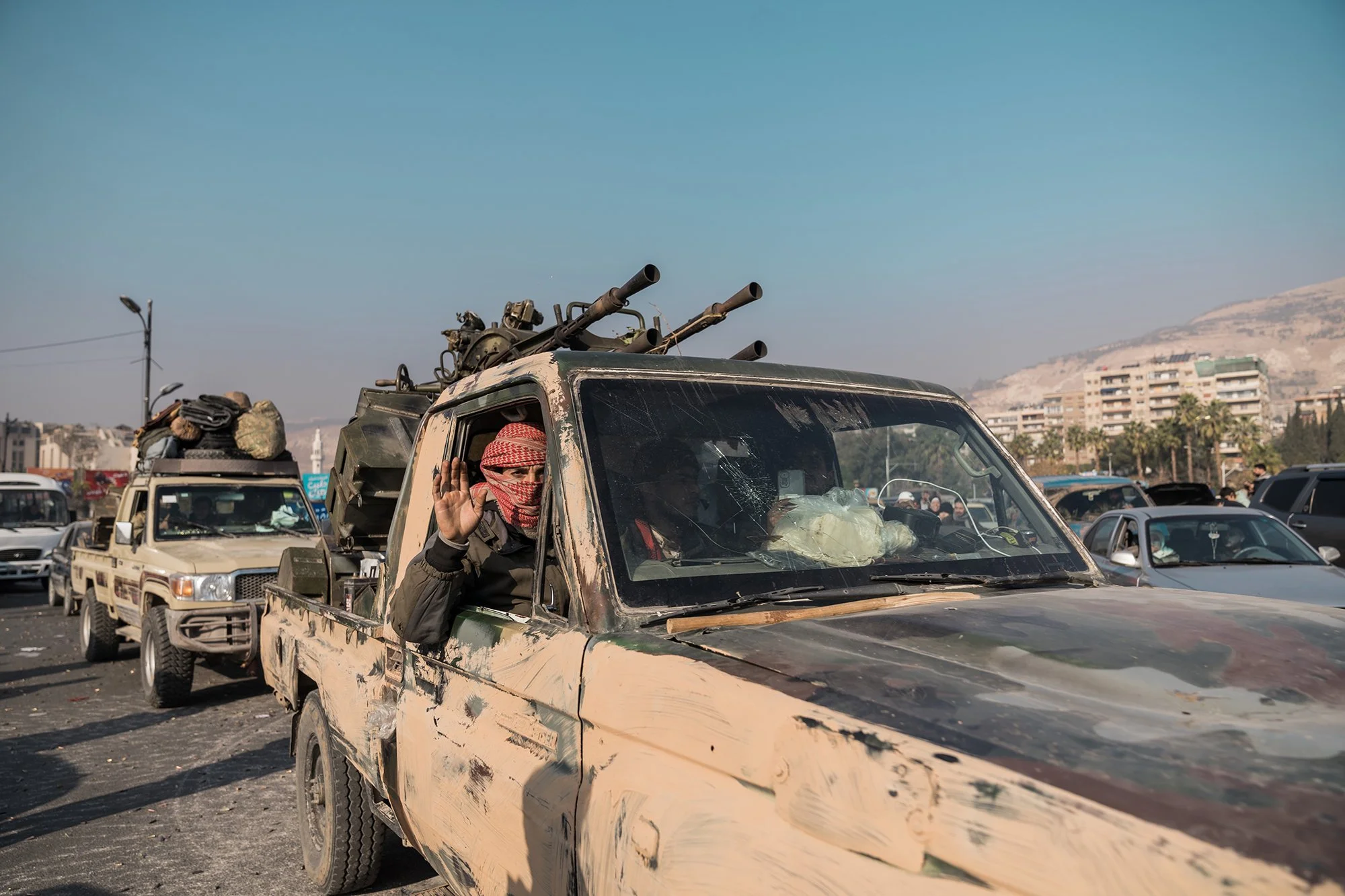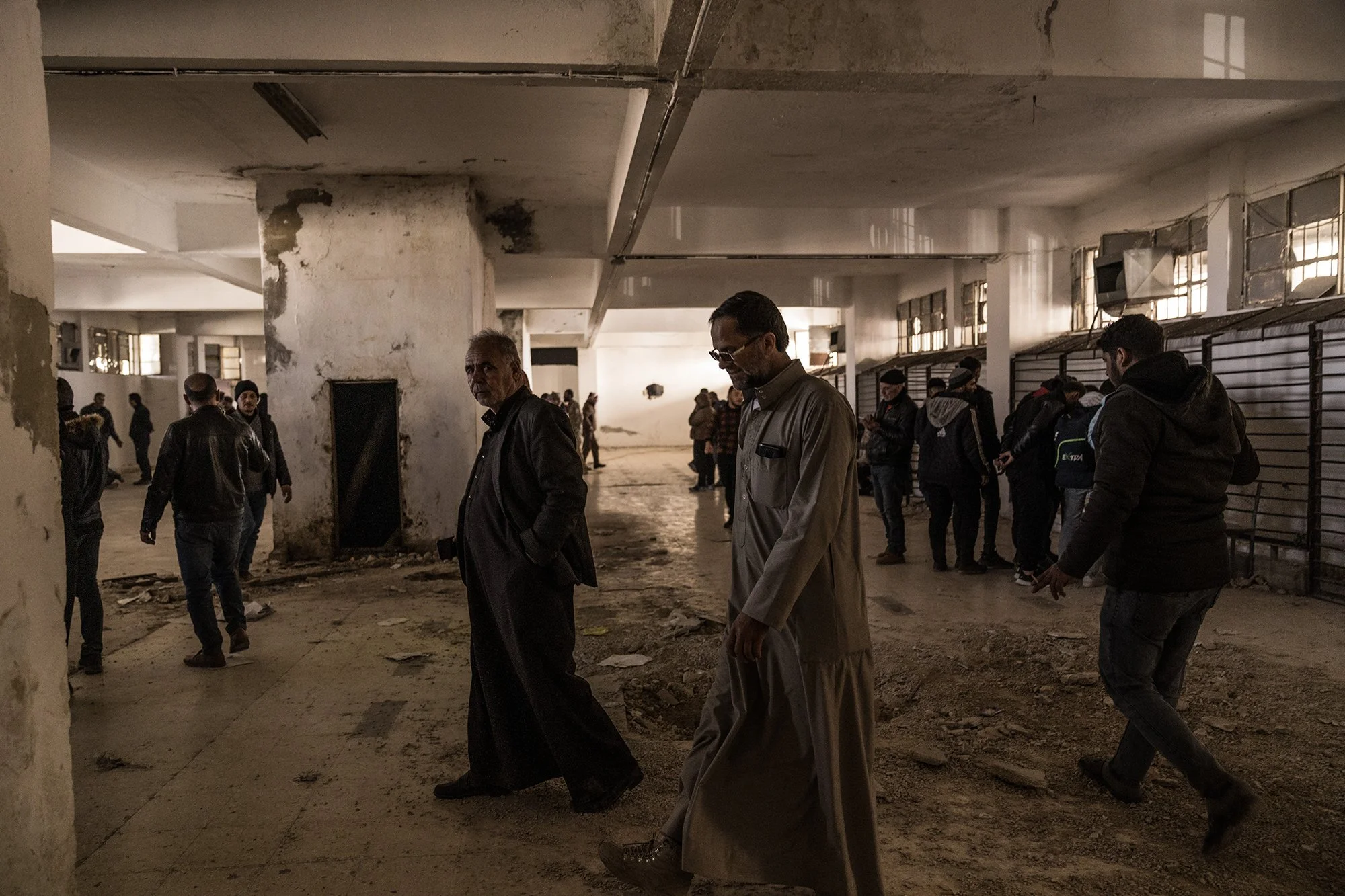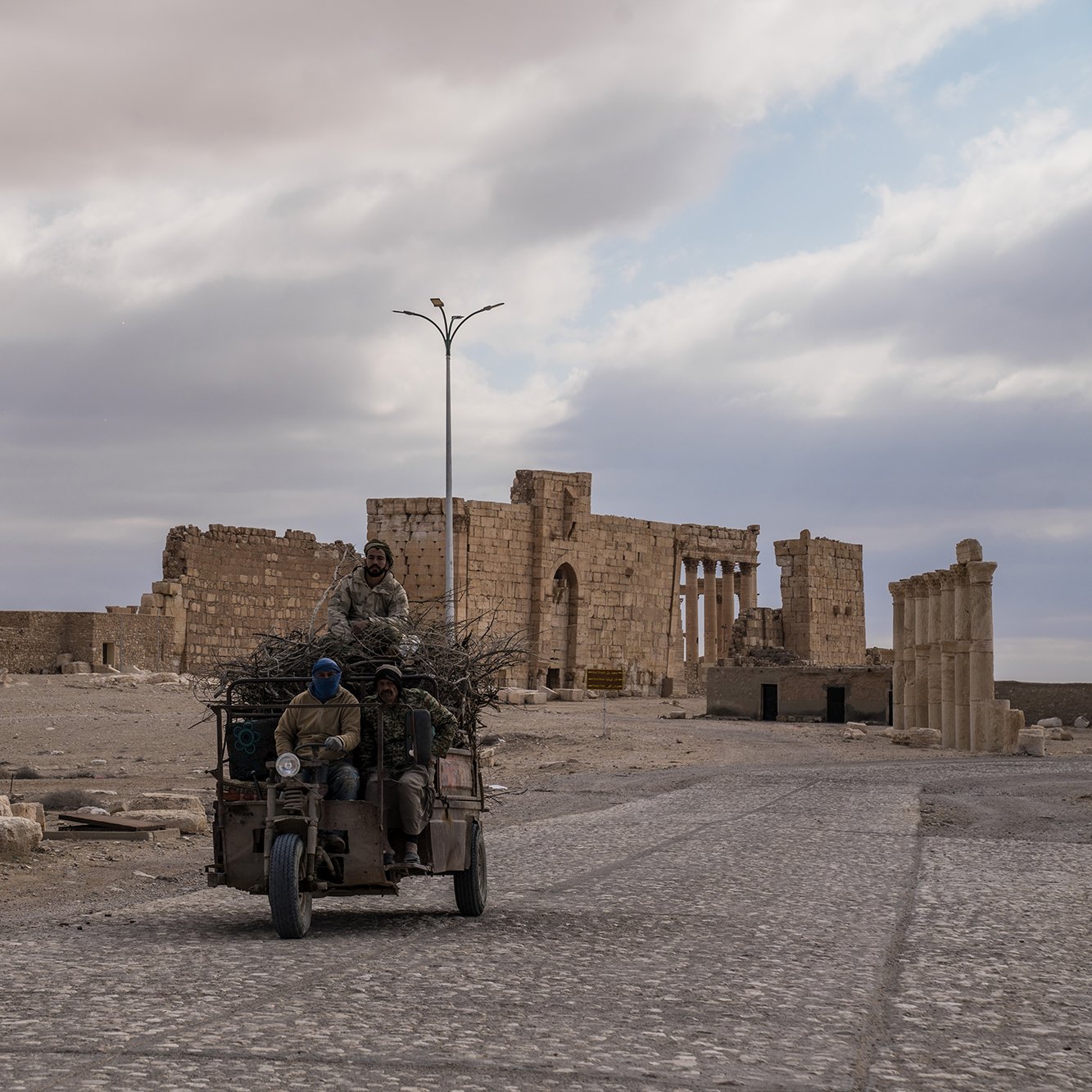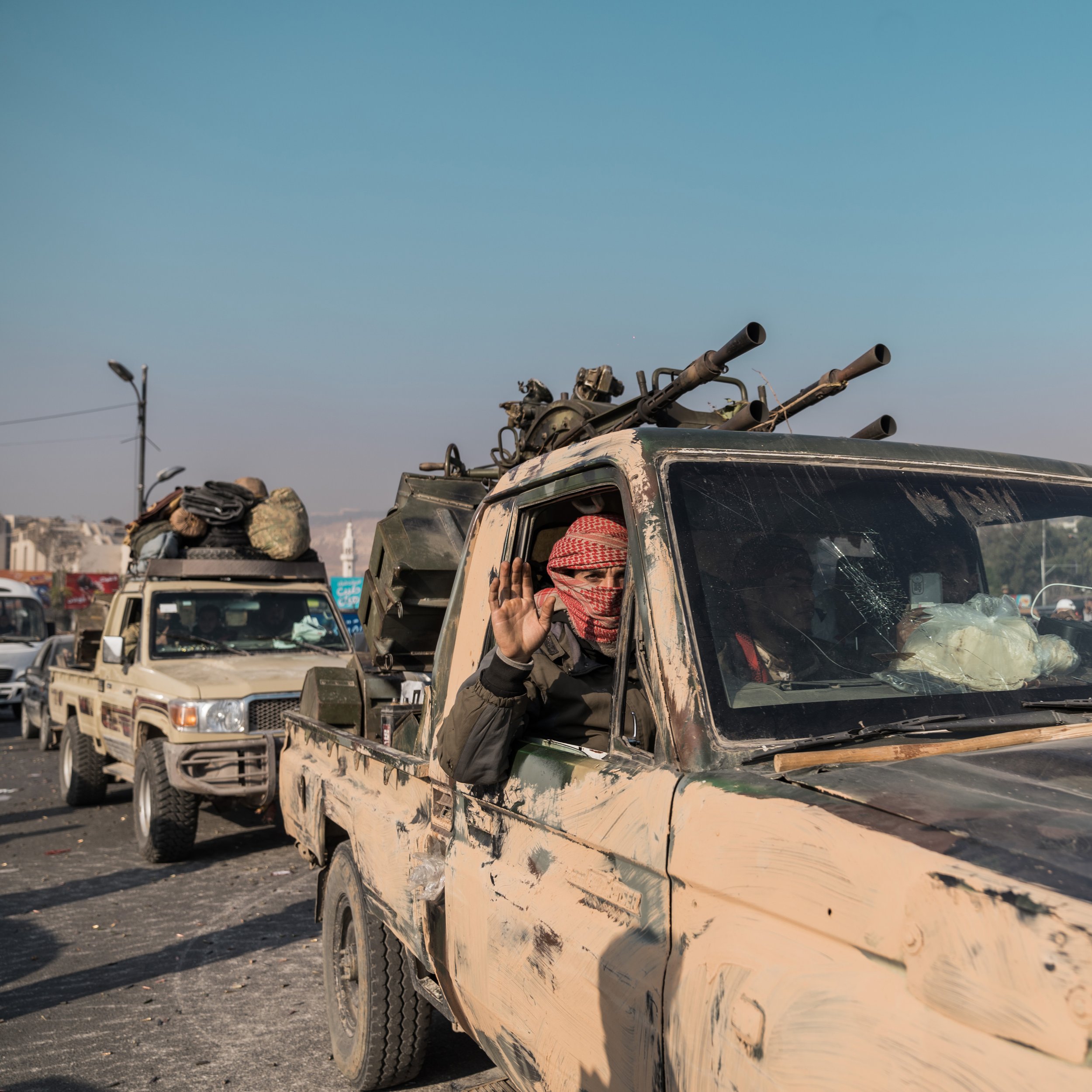“Forever Is Over”
The first days of post-Assad Syria.
DECEMBER 17, 2024
State of the World features occasional dispatches on the latest news, events, and ideas. To receive these updates directly in your inbox, sign up for our newsletter.
✺
This week, Justin Salhani reports from Damascus, Syria, after the fall of President Bashar al-Assad’s regime.
Fighters parade through Umayyad Square. (Photo by Raghed Waked)
On Monday, December 9, the road to Damascus from the Lebanese border was littered with abandoned military jeeps and tanks. Syrian army military jackets, abandoned by fleeing soldiers, lay on the ground around them. The regime of Syrian President Bashar al-Assad was over. The day before, the armed opposition had marched into Damascus as liberators.
When I drove from Lebanon into Syria on Monday morning, there was no one to check our passports. Most checkpoints stood empty, the doors of their stations flung open. Posters of the president and his father Hafez, who began the family’s tyrannical rule five decades earlier, had been defaced, shot through or ripped apart.
That first full day after the fall of the Assad regime was one of unreserved joy in Damascus. At Umayyad Square, in central Damascus, dozens of gunmen fired their rifles in the air in celebration. Locals, kicking away bullet shells lying on the ground, approached them for selfies. Civilians climbed on abandoned army tanks for photos with their hands held up in v-for-victory signs. “This is the best day of our life so far,” one fighter, still in his fatigues and carrying a rifle, said. “Today the whole world is happy.”
✺
Assad’s fall came both slower and faster than anyone could have expected.
Hafez al-Assad, Bashar’s father, came to power in 1971 and built a brutal police state. In 2000, Hafez died, and the Syrian constitution was altered so that his then 34-year-old son, who was studying optometry in London, could follow in his footsteps.
In his early days, Bashar enacted some minor economic reforms. But the police state and its notorious prisons remained. Minor infractions, such as using the word “dollar,” could land someone in jail for several decades.
When Syrians revolted against the regime to demand reforms and more rights in 2011, Assad responded with brutal repression. Rebel groups formed and took up arms against the state, leading to a civil war. In the first few years, the rebels made advances that had many international analysts predicting the fall of the house of Assad. But the intervention of Russia, Iran and the Lebanese group Hezbollah turned the tides back in Assad’s favor. With the help of its foreign backers, the regime retook most of Syria’s territory. The remaining Syrian opposition was pushed back into Syria’s northwest, around Idlib, where the Al-Qaeda offshoot Hayat Tahrir Al-Sham ruled.
In recent years, the economy was based on drug trafficking — primarily of captagon, an addictive, amphetamine-type stimulant — and property confiscation. The status quo led many to despair. In 2024, an estimated 13 million Syrians were either refugees or internally displaced. After 13 years of conflict, some states started to see normalizing relations with Assad as the only path forward. A common sentiment emerged — that the Assad family would likely stay in power forever.
In Damascus, I watched as people picked kumquats off trees in the front garden of a villa that used to belong to Assad and devoured the fruit.
But the fragility of Assad’s regime became apparent when his foreign backers got bogged down in their own wars. Russia’s attention turned to its full-scale invasion of Ukraine, while Hezbollah and Iran were battered by over a year of Israeli attacks.
Hayat Tahrir Al-Sham, an Islamist opposition movement that was ruling Idlib, and the Turkish-backed Syrian National Army, a coalition of opposition groups also based in the north, launched an operation to retake the city of Aleppo, which had fallen to the government following a brutal siege in 2016. Emboldened by their success, the fighters carried on to Hama and then to Homs in quick succession. Other forces moved up from the southern regions. Within a week, they’d marched onto Damascus with little opposition. Assad fled to Moscow in the middle of the night.
✺
The end of the Assad regime brought unrelenting joy to many. On social media, a phrase started to circulate: “Forever is over.”
One Syrian friend in his 60s, who fled the country and was sure he would never return, told me he cried for the first time in his life upon hearing the news. Another friend living in Istanbul could hardly speak through his joyful sobbing when I called him.
In Damascus, I watched as people picked kumquats off trees in the front garden of a villa that used to belong to Assad and devoured the fruit. Just a couple of days ago, this property had been off limits to the common Syrian. Now, dozens toured the garden and extravagant interior with their families, filming the scenes on their phones or video-calling their relatives abroad.
“We have been freed from the house of Assad,” 70-year-old Syrian Kamal Sermini told me with a wide smile, projecting his voice for all around to hear. “May God humiliate his father because he was such a bastard.”
But the elation felt by many Syrians is darkened by the anguish of searching for news of relatives who disappeared in prisons where death and torture were routine.
The road to Sednaya prison, north of Damascus, was packed with cars when I visited on Monday. Thousands of people drove as close as they could get and then continued on foot, weaving through traffic. Men and women, some carrying children, many carrying weapons or wearing fatigues, trekked up a dirt path to the huge complex in search of their missing loved ones.
Almost everyone had at least one missing relative. Some had as many as five or more.
Wael, a fighter with Hayat Tahrir Al-Sham, who sat with his Belgian rifle on the road leading to the prison, said he had helped liberate its prisoners on Saturday, December 7. The fighters found around 1,000 people inside. But his three missing cousins were not among them.
More than a week after liberation, thousands of victims of Assad’s brutal regime are still missing. Fadel Abdul Ghany, the executive director of the Syrian Network for Human Rights, told me that around 105,000 people have still not been found and that a majority were probably killed by the regime.
Inside Sednaya, where families are desperately searching for the more than 100,000 disappeared who are still missing and most likely dead, according to the Syrian Network for Human Rights. (Photo by Raghed Waked)
The last prisoner had been liberated from Sednaya the previous day, but on Monday afternoon the Syrian Civil Defense, commonly known as the White Helmets, were still searching the premises, trying to verify rumors of electronically locked doors and hidden underground chambers. People gathered around a man carrying water conductor rods, who was searching for gaps in the walls and floor. Almost everyone had at least one missing relative. Some had as many as five or more. Twice, the prison shook with loud blasts from Israeli airstrikes, ostensibly targeting Syrian military infrastructure nearby. On Tuesday, the White Helmets suspended the search after finding no more prisoners.
✺
When I returned to Syria a few days later, on Friday, December 13, a billboard on the highway to Damascus that previously read “Assad’s Syria welcomes you,” now simply said “Syria welcomes you,” with Assad scratched out.
That day, thousands of Syrians crowded into the Umayyad Mosque for the first Friday prayer after the liberation of Damascus. Others took part in celebrations in Umayyad Square.
Some would say Haybeh is lucky, as she is among the few who know the fate of her missing loved ones.
As these gatherings took place, I visited the towns of Zamelka and Douma in Eastern Ghouta, a suburb of Damascus. The area had been placed under siege during the early days of the war and bombed to smithereens. Entire blocks of buildings were reduced to ash. The suburbs were also targeted in chemical weapons attacks in 2013 and 2018, killing at least 300 people, including many young children. The Syrian Network for Human Rights says at least 1,514 suffocated to death from chemical weapons attacks during the civil war. Many of those who survived fled their homes. Now, some were starting to come back to see what was left and what they could rebuild.
Amina Haybeh, 60, sat in a chair outside her modest, and intact, home in Zamelka, which was otherwise mostly destroyed. Behind her, stood her 17-year-old grandson. Her other grandchildren would have been teenagers too had they not died in the chemical weapons attack 11 years earlier. She also lost a son that day. They’ll stay on her mind “until the day I die,” she said.
The news of Bashar’s ouster brought her immense happiness. But she couldn’t take part in the celebrations happening across the country, she said, because she had just received news that one of her sons, who was arrested by the regime in 2011, had been killed in prison in 2016.
Some would say Haybeh is lucky, as she is among the few who know the fate of her missing loved ones. At the Mujtahid Hospital in central Damascus, an employee told me that thousands of people filter in and out every day looking at the unidentified corpses. Of the 36 that were brought in from a military hospital, 14 remain unidentified. The bodies have “decomposed,” he said, “and many of their features had been lost.”
Outside the hospital, Mohammad Ismail Ismail looked through lists of missing people with their images, which had been posted on the hospital’s walls. He had made the 115-mile (184 km) trip from the city of Hama for a sign of his missing brother.
He had felt joy at the news of Assad’s fall, he said, but “it didn’t last long.” Tears appeared in the 52-year-old’s eyes as he spoke about visiting every prison, hospital and police station in the hope of finding a trace of his kin. Syria is free of the house of Assad, but not of the legacy it left behind. For Ismail, real freedom would mean knowing the fate of his long missing brother, even if he is no longer of this world. “It would be easier for us not to continue living with this hope,” Ismail said.






